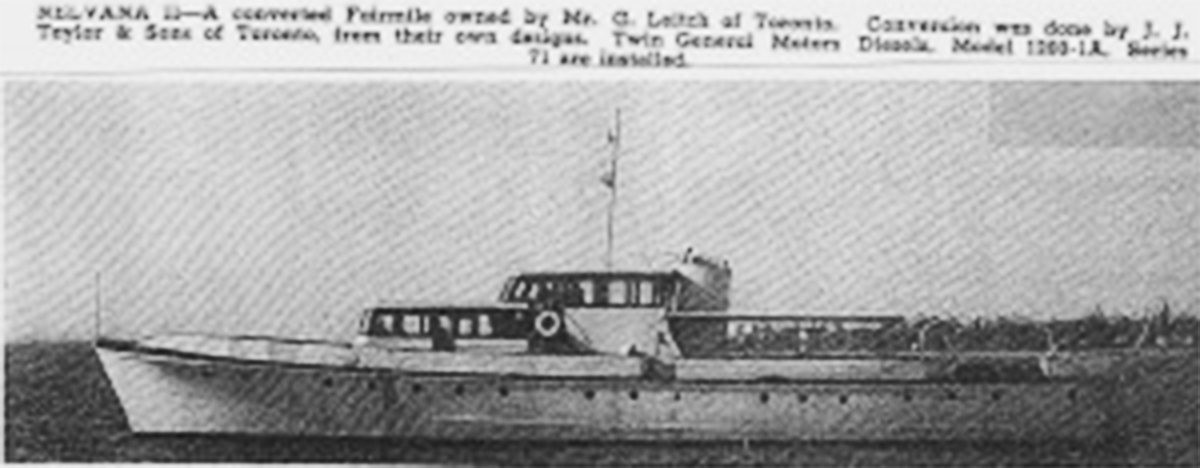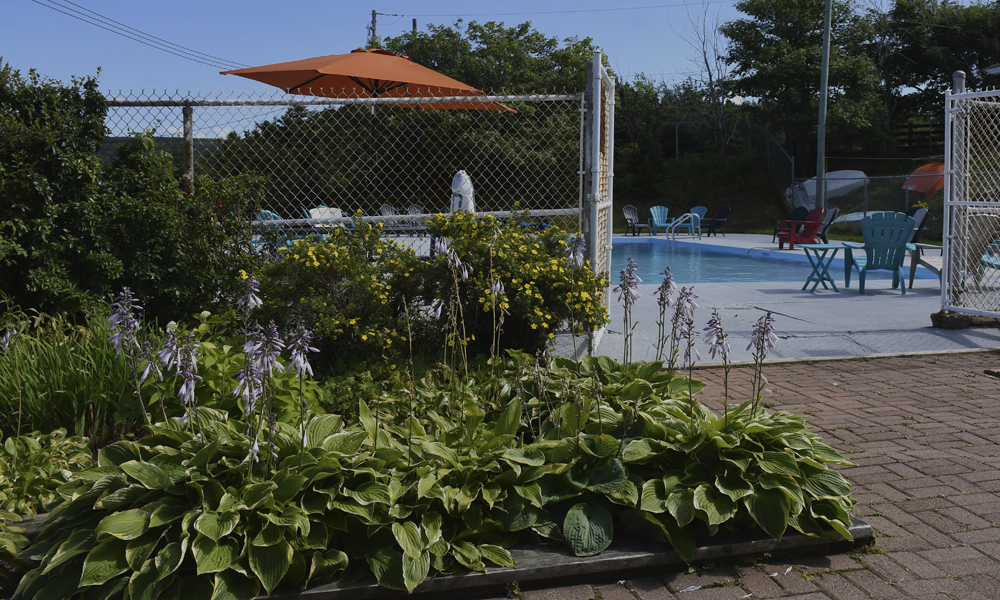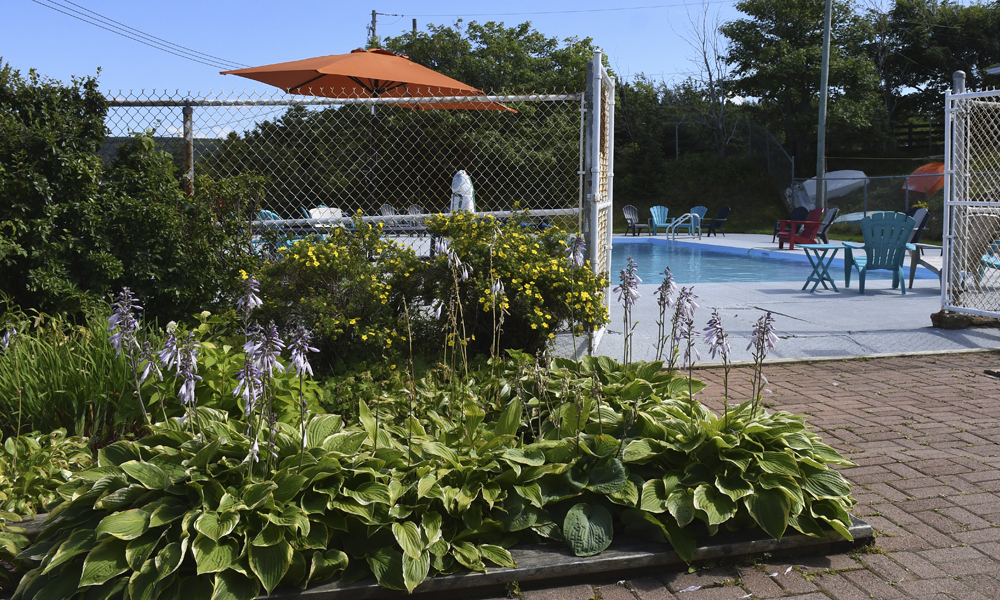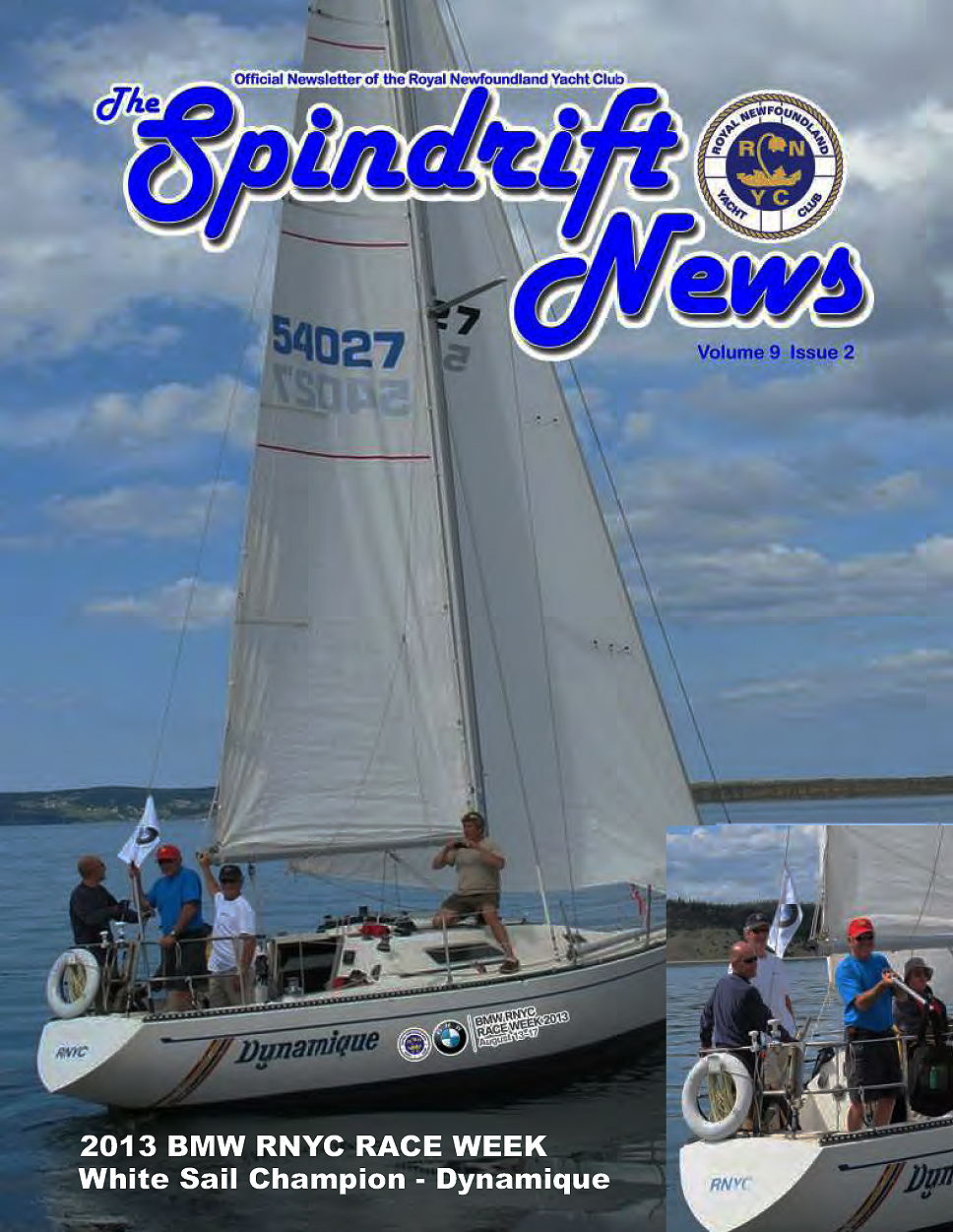HISTORY

![]() RNYC Beginnings
RNYC Beginnings
The Royal Newfoundland Yacht Club history began one lovely afternoon in August of 1935 when Arthur and Marjorie Johnson took Max Barbour canoeing at Long Pond. The Johnson’s wanted to fully show Max this beautiful sheltered haven with its many arms just 15 miles from St. John’s, and yet without a summer home on it. According to Arthur Johnson, Max’s mind took off like a rocket and he said, “Our maritime people must have a yacht club.”
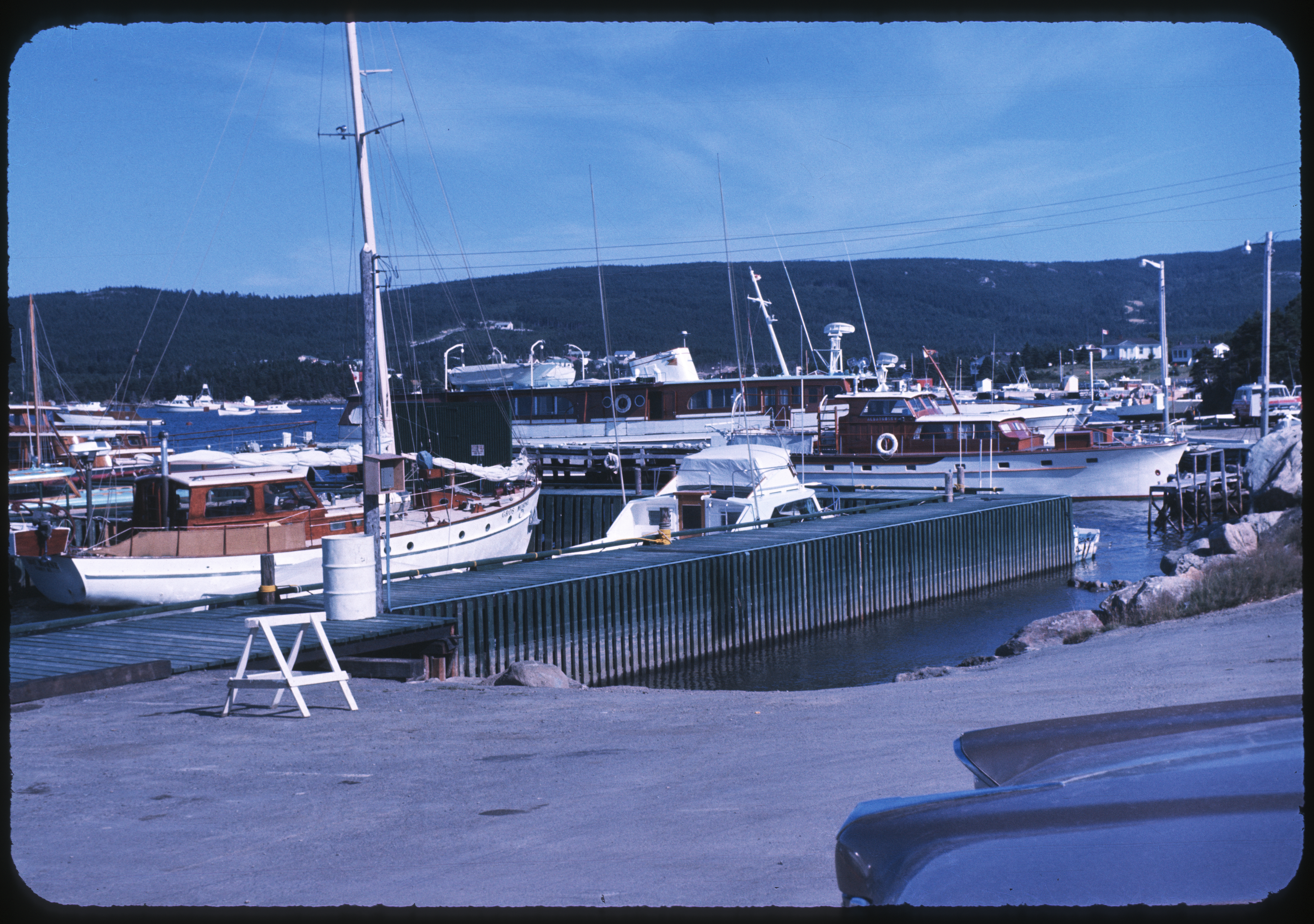
![]() A History of Boats
A History of Boats
The Oceola started life as one of 15 Fairmiles bult by John H. LeBlanc Shipyard, Weymouth, Nova Scotia and served with the Royal Canadian Navy out of Halifax as an antisubmarine destroyer.

![]() UPDATE – January 2017
UPDATE – January 2017
In 2002 Deanne Peters compiled an early history of the club and described the origins and evolution to the point that the clubhouse was established on the present site. This is an update to give the current membership a better idea of the efforts of the previous members and executives to make the club what it is today.

![]() Grounds and Wharves
Grounds and Wharves
The south wharf construction took place in the late 60’s and mid 70’s. In 1981 a floating dock system was designed to accommodate a long waiting list for wharves. When the tendered prices came in it was equivalent to a fixed dock which would have much lower life cycle and maintenance costs.

![]() Haulout & Launch
Haulout & Launch
The Travel Lift came into being when the Newfoundland Government decided to get out of the Marine Service Center business and put 3 machines on tender. The club submitted a bid for one of them and was successful in obtaining a 17 year old 50 ton machine...
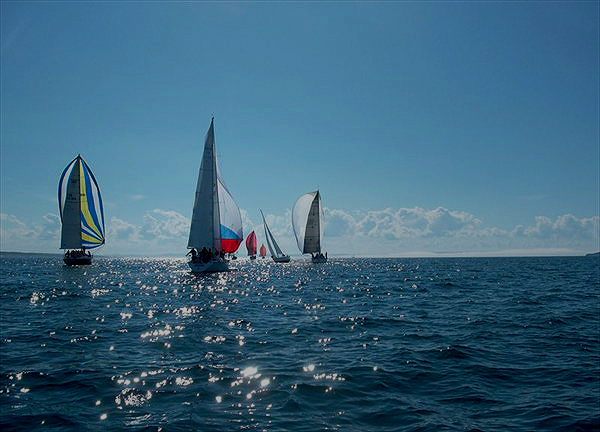
![]() Racing / Cruising / Learn to Sail
Racing / Cruising / Learn to Sail
The club has hosted several major national regattas and events. In 1983 there was a flotilla that sailed from Ontario to commemorate the 400th anniversary of the colonization of Newfoundland. In 1987 a group of over 40 boats from the Cruising Club of America (CCA) cruised to Newfoundland.
People watching boats near a 1955 Chevrolet.
According to a Daily News article of the time, the official opening of the Avalon Yacht Club took place on July 22, 1936. Dr. Will Roberts the first president of the club in his opening speech mentioned that amongst the activities would be boating and yachting, mackerel fishing, and boat races.
People watching boats near a 1955 Chevrolet.
According to a Daily News article of the time, the official opening of the Avalon Yacht Club took place on July 22, 1936. Dr. Will Roberts the first president of the club in his opening speech mentioned that amongst the activities would be boating and yachting, mackerel fishing, and boat races.
The Royal Newfoundland Yacht Club history began one lovely afternoon in August of 1935 when Arthur and Marjorie Johnson took Max Barbour canoeing at Long Pond. The Johnson’s wanted to fully show Max this beautiful sheltered haven with its many arms just 15 miles from St. John’s, and yet without a summer home on it. According to Arthur Johnson, Max’s mind took off like a rocket and he said, “Our maritime people must have a yacht club.”[1]
The following Spring on a cold day in April there was a meeting at Noseworthy’s beach, on the south side of Long Pond attended by Dinty Moores, Max Barbour, Gib Parsons, Arthur Monroe and Charlie Bell where they met for the first time young Ned Noseworthy who lived nearby. In a short while money was raised for a club by issuing shares and substantial land was purchased from the Noseworthy’s where a clubhouse 20 x 40 feet was built with washrooms, a kitchen, and a room where members could meet. Thus the Avalon Yacht Club was born.
According to a Daily News article of the time, the official opening of the Avalon Yacht Club took place on July 22, 1936. Dr. Will Roberts the first president of the club in his opening speech mentioned that amongst the activities would be boating and yachting, mackerel fishing, and boat races. The first boats to join this club were four small speedboats powered with 32 hp. outboard motors. Max Barbour, though, was a sailing enthusiast who soon came up with the idea of a fleet of small racing sailboats.
George Giannou remembers that “the following summer due to Max’s efforts about six snipes 15 1/2 ft. long, 5 ft. wide and each weighing about 500 lbs. appeared on the pond. Racing buoys were put down in 4 corners of the pond and whatever the wind conditions, we raced around three of them”. In just a few years these six snipes grew to sixteen with races on Wednesday afternoons, which was a regular half-holiday in those days. Competition was keen and very successful. Later there was also a Deep Sea Trophy for an annual snipe race around Kelly’s Island.[2]
By 1938 the Avalon Yacht Club was operating within a much more impressive building on the same site. This was Oxley’s Pavilion a grand facility built by Harold Oxley, which had a swimming pool, dance floor, a large outside deck, a roof garden, wharf, dining room and a room for members of the Avalon Yacht Club. It soon encountered financial hardship and in 1940 Arthur Johnson took over management of this ‘Yacht Dance Club’. In 1942 it was occupied by the Department of Civil Defense and laid out as an emergency hospital in the event of an air raid on St. John’s. In the early hours of April 8, 1943 a fire broke out near the kitchen area and with fuel stored inside, the building was destroyed within minutes. Soon a group of men put up the money to construct a second Avalon Yacht Club, which was later modified and extended. It is presently the summer home of Art and Nora Cahill.[3]
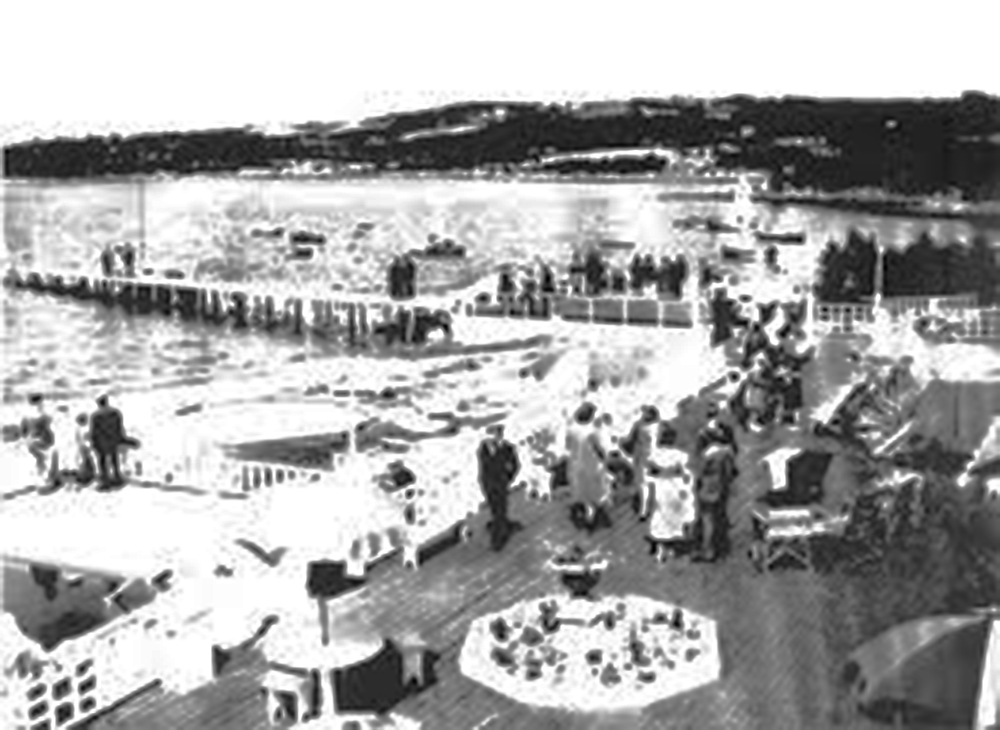
By 1938 the Avalon Yacht Club was operating within a much more impressive building on the same site. This was Oxley’s Pavilion a grand facility built by Harold Oxley, which had a swimming pool, dance floor, a large outside deck, a roof garden, wharf, dining room and a room for members of the Avalon Yacht Club. It soon encountered financial hardship and in 1940 Arthur Johnson took over management of this ‘Yacht Dance Club’. In 1942 it was occupied by the Department of Civil Defense and laid out as an emergency hospital in the event of an air raid on St. John’s.
In the early hours of April 8, 1943 a fire broke out near the kitchen area and with fuel stored inside, the building was destroyed within minutes. Soon a group of men put up the money to construct a second Avalon Yacht Club, which was later modified and extended. It is presently the summer home of Art and Nora Cahill.

This was to be the home-base for The Newfoundland Swimming, Boating and Tennis Club. As such, the complex offered bathing houses, a pool supplied with salt water, kiosks selling candy, ice cream and novelties, a tea house, motorboats on the bay with capacities for 28 and 22, clinker-built row boats, decks with outdoor chairs ... there was golf, shuffle board, dancing ... Mr. Bob McLeod would conduct a five-piece orchestra on-site. Throughout the summer, there were to be 47 uniformed staff. All told, it was a big venture and in those years of worldwide depression, surely it was also a source of pride for all.
The first Avalon Yacht Club prior to Oxley’s Pavilion had been divided for summer homes with Arthur Johnson taking one half and Dinty Moores the other. Meanwhile in 1950 when St. John’s harbour was getting quite crowded, it was decided by government to turn upper Long Pond into a secondary harbour where a large wharf was built and within a few years talc was shipped out. This created an opportunity for those who wanted to get involved with larger pleasure boats and within a year there were 10 power cruisers in the upper pond. George Giannou remembers, “We couldn’t join the Avalon Yacht Club as we couldn’t get down there.”
It was 1955 when the drawbridge, close to the site of the present Royal Newfoundland Yacht Club was removed to prepare the way for dredging. This act created ill will between the boaters and local residents who had previously had longtime access to the beach for caplin and for recreation. The following year in 1956 the upper harbour was dredged to make it larger and through the efforts of Ches Pippy and Jim McGrath who was the Federal Member, the channel to the lower pond was also dredged. This enabled larger boats to come down to the lower pond and by 1957 this powerboat group decided to establish a headquarters there.
There was a small piece of land available on the point in the channel and it was purchased from Ewart Pratt and James Halley who had bought it a few years previously from the Bishop Estate. Shares were sold, other people joined and a building was constructed 20 ft. wide and 30 ft. long. This was the nucleus of the present building and the home of the Newfoundland Yacht Club whose first Commodore Dr. Dinty Moores served from 1957 to 1959. For the next few years two clubs existed on the pond until 1960 when Arthur Johnson of the Avalon Yacht Club proposed that the two clubs merge into the Newfoundland Yacht Club, which they did. In 1961 the swimming pool was built and it was in 1964 through the efforts of Cal Pratt and the offices of Federal Minister Jack Pickersgill that the title of ‘Royal’ was granted to the club.
[1]“By the mid-1920s, Arthur Johnson had established a strong career in local business as president of his family’s insurance company and manager of other notable enterprises. In the latter part of the decade, Johnson began to serve in an executive capacity in several sporting bodies. He held a prominent position on the athletics scene in Newfoundland into the 1930s, when he would turn his hand to organizing ice hockey and basketball. For his efforts, Johnson was elected to the Newfoundland and Labrador Sports Hall of Fame in 1978.”
Fred Mason, A ‘New-found’ Olympic Nation —Newfoundland’s Involvement with the Olympic Games, 1904-1934, p 308.
Note: A dsicrepency in the year that Arthur Johnson was “elected” and/or “inducted” into the Sports Hall of Fame exists between Fred Mason’s account and the Sport NL account in the following.
Sport NL https://sportnl.ca/hall-of-fame/arthur-johnson-builder/ Inducted October 15, 1977 In the local sports sphere Arthur Johnson first came to prominence in the early twenties mainly through his association with the Guards athletic organization... Johnson is however best known for his lengthy association as a sports organizer and notably for his promotional and managerial capacity in fostering interest in local hockey.
[2]George Christos Giannou was a founding member and the second Commodore of the Royal Newfoundland Yacht Club in 1960 and 1961. He was an active sailor and also a Past President of the St. John`s Curling Club and represented Newfoundland in four Briers and one National Senior`s Brier. He was one of Newfoundland`s most active senior curlers.
[3] “In June of 1935, work on an exciting new pavilion and recreation complex raced toward completion at Topsail Beach. The big opening event was scheduled for July 1 that year when the Hon. Frederick Alderdice (in charge of Home Affairs in our Commission of Government) would come out from St. John’s to do the honours. Privately owned by Harold Oxley, “the club” was no small venture. A beach popular with residents of the area and people from St. John’s, and sheltered from the capital’s persistent easterlies and fog-blankets, was about to be turned into something even better.
This was to be the home-base for The Newfoundland Swimming, Boating and Tennis Club. As such, the complex offered bathing houses, a pool supplied with salt water, kiosks selling candy, ice cream and novelties, a tea house, motorboats on the bay with capacities for 28 and 22, clinker-built row boats, decks with outdoor chairs ... there was golf, shuffle board, dancing ... Mr. Bob McLeod would conduct a five-piece orchestra on-site. Throughout the summer, there were to be 47 uniformed staff. All told, it was a big venture and in those years of worldwide depression, surely it was also a source of pride for all.
The club’s life would be short-lived.
In September a devastating flash fire destroyed just about everything. As one of our newspapers reported, “all that remains are the chimney, fringe of the outside lower boardwalk, part of the wharf and part of the swimming pool for children.” It was reported that as the building was “of hollow construction”, the fire “roared” through it “and it was impossible to save anything.”
The sense of loss is keenly described in the reporting customs of the day: “Mr. C. A. Pippy moved out his speed boat and outboard engine, valued at about $1,000. Mr. Arthur Johnson moved out his canoe, but a canoe belonging to Mr. Ainslie Joy, which was on the premises was partially burnt. Mr. and Mrs. Oxley lost everything but what they were standing in.”
It was also reported “a Chinaman who leases space for a restaurant on the south side of the building, raised the alarm and within thirty minutes the building was razed to the ground.”
Can you imagine one — one sad little fire truck from St. John’s tried to reach the site from the Central Fire Hall (where The Rooms is now located) over the gravel highway. “A pumper was sent out from the central fire hall and the firemen put out the fire in the embers, the building being almost destroyed before they arrived.”
https://www.thetelegram.com/news/local/paul-sparkes-in-the-eye-of-the-beholder-129689/ Paul Sparkes: In the eye of the beholder / A pavilion at Topsail, The Telegram, May 21, 2017.
See also: Reference: Melissa Collins: RNYC Long Pond Dredging Project, MUN 2013.
Royal Newfoundland Yacht Club circa 1965. At far left is the motor sailer Gros Morne. Right midground is the motor yacht Albatross. In the background is the 112 foot motor launch “Oceola” belonging to Ches Pippy.
Although a luxurious pleasure boat when she arrived in Newfoundland, the Osceola started life as one of 15 “Fairmiles” built by John H. LeBlanc Shipyard, Weymouth, Nova Scotia and served with the Royal Canadian Navy out of Halifax as an antisubmarine destroyer.

Royal Newfoundland Yacht Club circa 1965. At far left is the motor sailer Gros Morne. Right midground is the motor yacht Albatross. In the background is the 112 foot motor launch “Oceola” belonging to Ches Pippy.
Although a luxurious pleasure boat when she arrived in Newfoundland, the Osceola started life as one of 15 “Fairmiles” built by John H. LeBlanc Shipyard, Weymouth, Nova Scotia and served with the Royal Canadian Navy out of Halifax as an antisubmarine destroyer.
Osceola
The early days of the Royal Newfoundland Yacht Club was a time of classic wooden runabouts and luxurious motor launches. Among the grandest of these was Ches Pippy’s “Osceola”. Although a luxurious pleasure boat when she arrived in Newfoundland, the Osceola started life as one of 15 “Fairmiles” built by John H. LeBlanc Shipyard, Weymouth, Nova Scotia and served with the Royal Canadian Navy out of Halifax as an antisubmarine destroyer.
Photo: The Nelvana II (Osceola) as she was in 1960. Note: Osceola is an historic past leader of the Seminole people of Florida. As the Nelvana II, the Osceola was wintered in Florida.
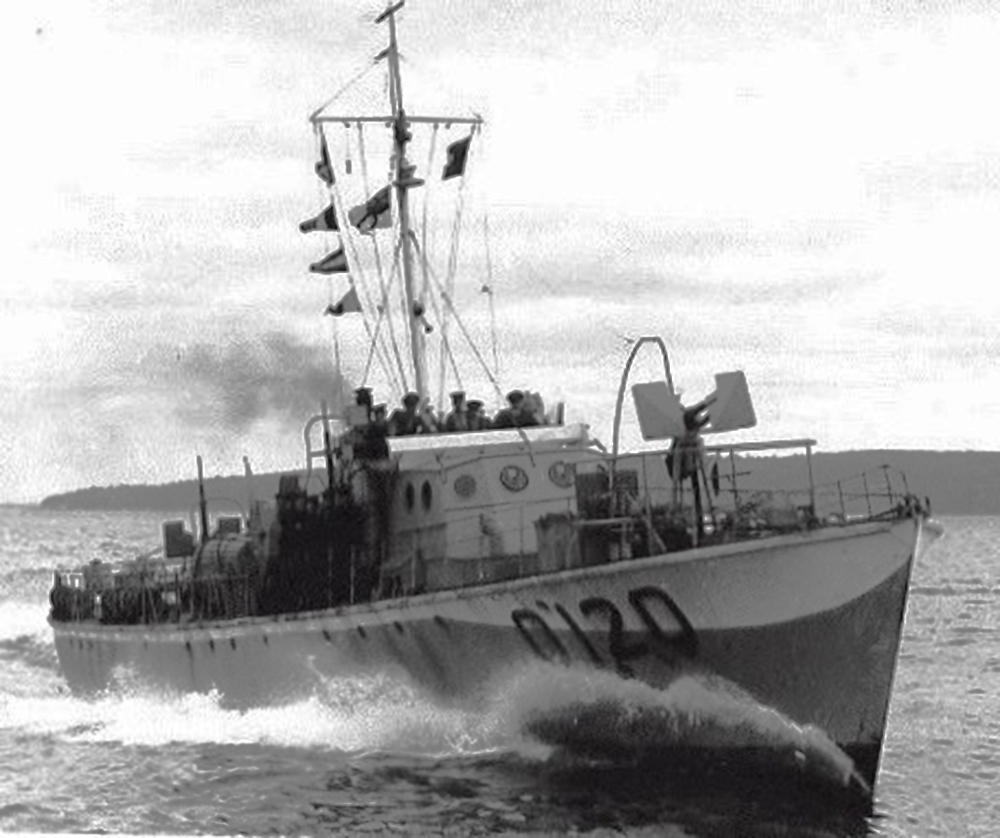 A 112 foot conversion yacht with an 8 inch oak keel, diagonally doubled mahogany planking, and plywood interior bulkheads, the Osceola was originally one of eighty such motor launches built for the Royal Canadian Navy after a design by W.J. Holt of the British Admiralty. Based on a British-built line of destroyer hulls, the “Fairmiles” arrived in prefabricated kits from various British furniture and piano makers to be assembled for the RCN by thirteen different Canadian boatyards. The boat that would become Osceola was originally listed as the ML 120 later named Q120.
A 112 foot conversion yacht with an 8 inch oak keel, diagonally doubled mahogany planking, and plywood interior bulkheads, the Osceola was originally one of eighty such motor launches built for the Royal Canadian Navy after a design by W.J. Holt of the British Admiralty. Based on a British-built line of destroyer hulls, the “Fairmiles” arrived in prefabricated kits from various British furniture and piano makers to be assembled for the RCN by thirteen different Canadian boatyards. The boat that would become Osceola was originally listed as the ML 120 later named Q120.
Photo: HMC ML120 (Q120) outbound from Halifax under full power. Years later when sold to the State of Maryland as the Governor’s yacht this photo hung in the stateroom of the “Maryland Independence” between photographs of Reagan and [Gorbachev].[1] Click on photo to enlarge.
After an initial tendering process, the finished price was fixed for all east coast builders at $85,000; slightly less for the west coast builders. Adjusted for inflation, that’s approximately $1.5 Million in 2020 – amazingly inexpensive for a 112-foot boat. As a measure of its versatility and worth, some seven hundred Fairmiles were built by thirteen different nations during the war years.[2]
The Q120 had an LOA of 34.14 metres or 112 feet, a beam of 5.43 metres or 17 feet 10 inches and a gross tonnage of 151 Tonnes. The boat was built with two 850 HP Sterling Admiral Engines making her capable of up to twenty-four knots according to her builders but said to achieve closer to 20 to 21 knots by others. Later the yacht was equipped with 2 Volvo 312 H.P. 6 cyl. turbo-charged diesels.
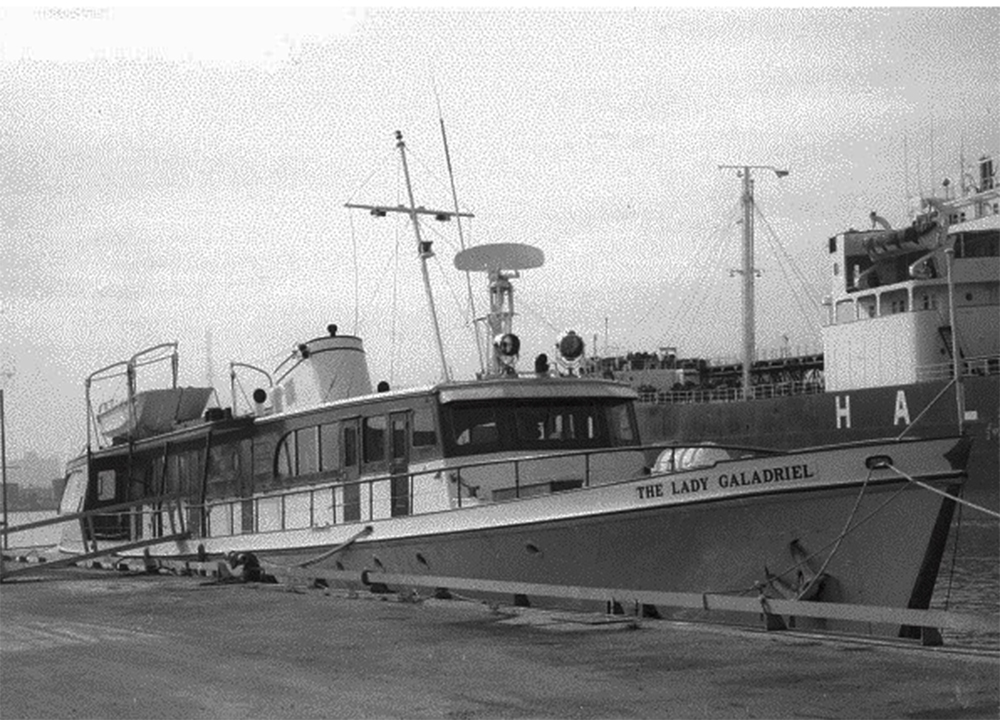 Sold in 1945 to Upper Lakes and St. Lawrence Transportation Company, Toronto, the Q120 was renamed “Nelvanna II”. On October 19, 1960 Nelvanna II was sold to Newfoundland Tractor & Equipment Co. Ltd., St. John’s, Newfoundland as a private yacht for Ches Pippy family and was renamed the “Osceola”.
Sold in 1945 to Upper Lakes and St. Lawrence Transportation Company, Toronto, the Q120 was renamed “Nelvanna II”. On October 19, 1960 Nelvanna II was sold to Newfoundland Tractor & Equipment Co. Ltd., St. John’s, Newfoundland as a private yacht for Ches Pippy family and was renamed the “Osceola”.
The boat was purchased for $30,000 in 1974 by Joan A. Molz of Toronto, Ontario and renamed “The Lady Galadriel”, a character form J.R.R. Tolkien’s Lord of the Rings. In 1977 The Lady Galadriel was sold to a company in Delaware.
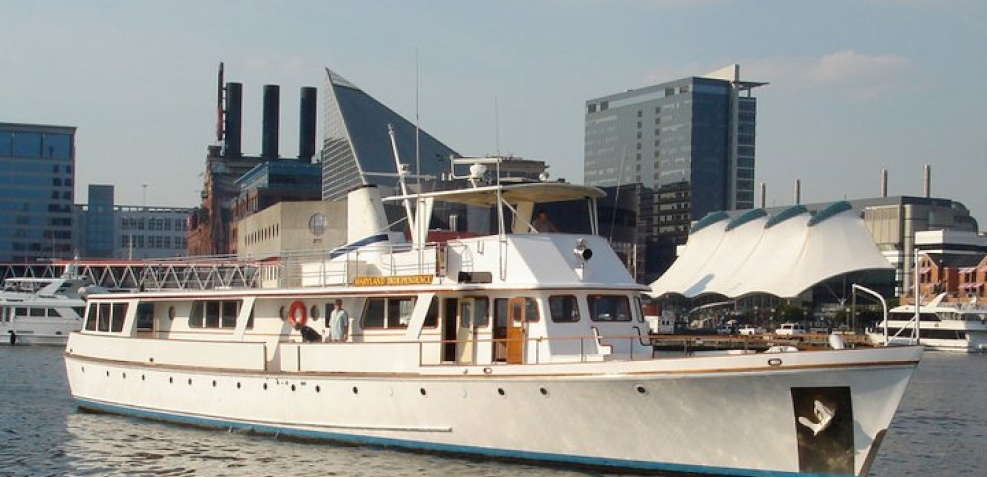 In 1986 The Lady Galadriel was purchased by the State of Maryland for more than $600,000 and renamed “Maryland Independence” and became the Governor’s “swanky” entertainment yacht. In the early 2000’s, due to austerity measures and the boat’s $230,000 annual maintenance costs, Gov. Robert Ehrlich had the boat listed on E-Bay for $300,000. Maryland Independence was sold in 2004 for $275,100 to Mr. Paul Davies and Julie Wood of Maryland.[3]
In 1986 The Lady Galadriel was purchased by the State of Maryland for more than $600,000 and renamed “Maryland Independence” and became the Governor’s “swanky” entertainment yacht. In the early 2000’s, due to austerity measures and the boat’s $230,000 annual maintenance costs, Gov. Robert Ehrlich had the boat listed on E-Bay for $300,000. Maryland Independence was sold in 2004 for $275,100 to Mr. Paul Davies and Julie Wood of Maryland.[3]
Photo: The Maryland Independence is one of the last of the Fairmiles in active use.
Researched and written by Richard Austin 2020.
[1] Photo: HMC ML120 outbound from Halifax under full power. Department of National Defence Photo.
In Jan 1944, the ML 120 (Motor Launch 120) was named Q120 and was part of the 82nd Motor Launch Flotilla, Shelburne, NS. In Jan 1945, her Commanding Officer, Lieutenant commander John Maxwell Todd was SO of the 82nd ML Flotilla.
See: http://www.jproc.ca/rrp/fairmile2.html
See also: https://fairmilesofweymouth.com/ml-120/
The boat was purchased in 1974 by Joan A. Molz (wife of Herbert F. Molz), of Toronto, Ontario and renamed “The Lady Galadriel”. (The boat was purchased for $33,000 according to Stephen Molz, June 2010).
[2] https://www.boatblurb.com/post/before-fibreglass-world-war-two-and-the-fairmile-part-11
Following the war and for a ridiculously low fixed price of $3,500 (considering some were less than a year old), several Canadian Fairmiles were sold to foreign governments, while six were kept by the RCN as training ships on the Great Lakes through the 1960s. Most were snapped up by commercial shipping or transport companies and eventually ended up abandoned, burned, or scrapped in the 1970s and 80s.
[3] The Baltimore Sun. “Boat lovers’ maneuvering keeps state yacht in state” https://www.baltimoresun.com/news/bs-xpm-2004-01-24-0401240130-story.html
“For good measure, Wood tacked $100 onto the figure she expected her rival - a bidder from California - to enter. She was correct: Her offer of $275,100 was just enough to land the prize.”
See also: https://www.boatblurb.com/post/before-fibreglass-world-war-two-and-the-fairmile-part-11
https://www.yachtcharterfleet.com/luxury-charter-yacht-49523/maryland-independence.htm
http://www.azinet.com/Annapolis/photo3.htm
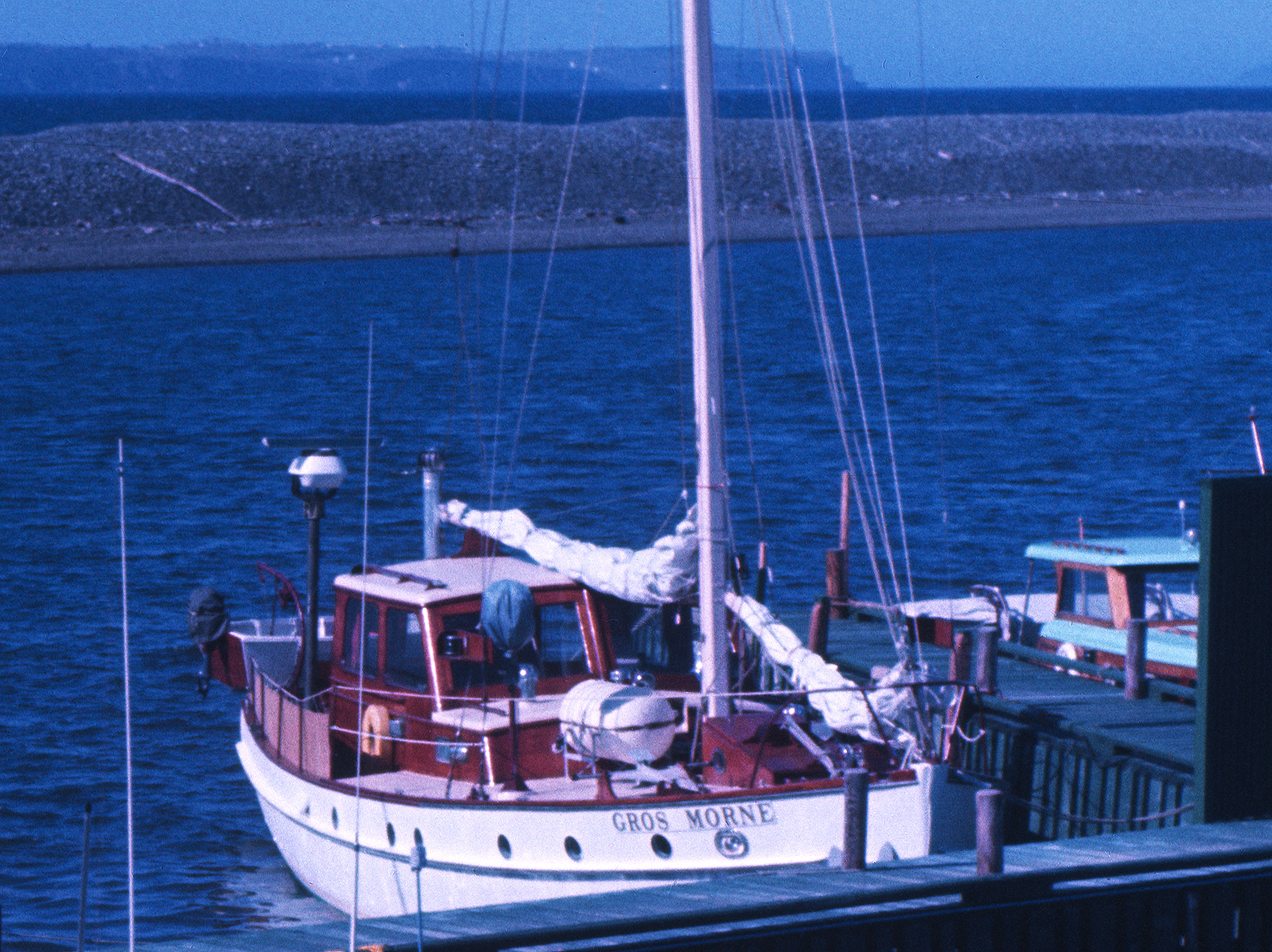
Gros Morne
The Gros Morne is a 40 foot motorsailer designed by Walter J. McInnis (1893-1985) of Eldredge-McGinnis Inc. for Steers Limited merchantile of Newfoundland as a means of reaching the outports of Newfoundland prior to the advent of roads. The boat was built by the Pinaud Boat Yard of Baddeck Nova Scotia. It is believed the Gros Morne was owned by Lloyd Peddle at the time this photo was taken.
 “The power is supplied by a General Motors 4-71 diesel driving through a [2.5:1] reduction gear. With a fuel capacity of 300 gallons the Gros Morne [had] a cruising radius of about 650 miles with 9 knot speed. The working sail area totals 601 square feet. Displacement is 14 tons with 4,100 pounds of iron as ballast.”[2]
“The power is supplied by a General Motors 4-71 diesel driving through a [2.5:1] reduction gear. With a fuel capacity of 300 gallons the Gros Morne [had] a cruising radius of about 650 miles with 9 knot speed. The working sail area totals 601 square feet. Displacement is 14 tons with 4,100 pounds of iron as ballast.”[2]
Researched and written by Richard Austin.
[1] [Walter] Pinaud established his own yard in Baddeck in 1926 and designed and built both sail and power boats there with his sons Ralph and Fred until his death in 1968.
[2] Motor Sailer 39'10½" x 35' x 12'11¼" x 4'6", Rudder Magazine February 1958, p34.
Royal Newfoundland Yacht Club swimming pool.
The pool was built in 1961 and there have been continuous repairs and upgrades including a new deck. Initially it was a salt water pool and in 1973 was converted to fresh water.
Royal Newfoundland Yacht Club swimming pool.
The pool was built in 1961 and there have been continuous repairs and upgrades including a new deck. Initially it was a salt water pool and in 1973 was converted to fresh water.
Introduction
In 2002 Deanne Peters compiled an early history of the club and described the origins and evolution to the point that the clubhouse was established on the present site. This is an update to give the current membership a better idea of the efforts of the previous members and executives to make the club what it is today. Just to give you some idea of the cost of the progress, in the mid 70’s there was an initiation fee of $100 and the yearly fee was $75. This translates to $578 and $434 respectively in 2016 dollars. The initiation fee was increased to $900 in 1991 ($1400 in 2016), and remained in effect until 1993 when it was dropped to encourage an increase in membership.
Clubhouse and Pool
In 1977 the club hosted the Canada Summer Games and many improvements were made for this event. A large renovation was completed in the basement and an addition constructed in the front of the club to accommodate a new ward room, locker room and washrooms which were later upgraded circa 1988. The lockers were then removed and the area now known as the Bell Room was created as well as the washrooms as we have them today.
The large parking lot on the west side of the property adjacent to the Campbell property was paved at that time and the present chain link fence and entrance was constructed. Permanent moorings were installed in the pond to accommodate the 12 new identical C&C 24 ft keelboats for the games. Many of these boats remained in the local area for some time. A fleet of new lasers were kept in racks by the channel and launched near the western fence. It should be noted that the current manager’s office was a wardroom and was used for meetings. The manager occupied a small office at the back of the kitchen until the move in 1984. Back in 1977 there were 204 full, 5 senior and 23 junior members.
In 1980 there was a tragic event that resulted in a new chain link fence being erected to encircle the pool. During the Sailpast that year a young girl from the area walked onto the property while boats were on the water for Sailpast. When the boats returned she was found floating in the pool and was not able to be revived. It has been fenced and gated with a lock and supervised ever since.
The pool was built in 1961 and there have been continuous repairs and upgrades including a new deck. Initially it was a salt water pool and in 1973 was converted to fresh water. In 1976 a new filter system was installed and in 1983 a new deck was installed. In 1984 there was a solar heating system installed, but subsequently removed at a later date. 2014 a new liner was installed to prolong its life. In 2015 new heating system was installed. The playground equipment is now within the pool area and has also been upgraded continuously. There has been continual maintenance done in the area such as decking and the removal of a diving board and water slide.
Inside the club things have also been progressing. One milestone was the introduction of Chargex in 1978 and in 1996 a minimum charge for kitchen and bar was introduced. In 2000 the club became partially smoke free and in 2002 100% smoke free.
The bar was redesigned by Philip Pratt and in 1985 a major renovation done to the bar area/dining area. A free standing fireplace was constructed to divide the bar from the upper seating area but later removed to provide an easier flow of traffic in the bar area. The copper hood from the original fireplace has been used for the new propane fireplace opposite the bar area.
A room which was a former locker room and subsequently a kids’ play area was renovated with partial funds from the Bell family. Later in 2010 the seating area in front of the bar was replaced by dining area and it was moved to what was referred to as the Bell Room. It was subsequently officially named in honour of Charles R. Bell in 2012, one of the founding members.
 Flooring and new windows and a major redecorating have also been done to the main dining area as part of the upgrading to the interior as well and renovations to the lower washrooms and adjacent area.
Flooring and new windows and a major redecorating have also been done to the main dining area as part of the upgrading to the interior as well and renovations to the lower washrooms and adjacent area.
In 2012 the kitchen was significantly upgraded to comply with current building and fire safety codes with a fire suppression system and in 2014 with a new floor and grease pit. The ventilation system was previously upgraded to provide some relief for our long serving and dedicated kitchen staff.
Downstairs in 1991 a door was placed in the main corridor and in 1996 there was a major upgrade to the washrooms including new showers and another upgrade was completed in 2002.
In 2010 a defibrillator was installed in the section which has access from outside at any time, though sometimes a key must be used. This key can be obtained by any member for a deposit from the manager.
In the 1970’s and 80’s there was a very active ladies committee that organized social events and raised funds by projects such as writing and publishing a cook book. The junior members were also an active group and organized their own social events.
The south wharf construction took place in the late 60’s and mid 70’s. In 1981 a floating dock system was designed to accommodate a long waiting list for wharves. When the tendered prices came in it was equivalent to a fixed dock which would have much lower life cycle and maintenance costs. It was redesigned and tendered again. To finance the project the club set up a program to prepay wharf space whereby members had 3 options to put up the required $3000 needed. A deferred wharf account was set up for each member to be drawn down until the deposit was eliminated and then went on the current yearly fee. This practice ended in 1997 when all users went on an annual fee. The design was to extend the existing south dock by 180 feet and to slightly extend and create several slips on the north wharf. In all, 29 new slips were created.
The first 100 foot section of the original south wharf was replaced in 2010. The remainder was replaced in 2013. Between 1982 and 2013 major repairs were done including new outside piles and additional catwalks. In 2000 wharf expansion and repair projects required floating equipment and a pile driver was designed and constructed by the club. RNYC then leased it to a contractor who maintained it and did the necessary wharf work of the adding of catwalks to many of the slips. The pile driver is still in the club’s possession and kept on the Perrin’s Road property where boat cradles are stored during the summer. The Perrin’s Road property was purchased in 1973 for future haulout area but has subsequently been used for summer storage of cradles.
The north wharf began to grow in the late 70’s with an extension of 225 feet in 1977/78. The last extension to the north wharf was done in 1986. In 1991 additional piles were placed in the channel and 12 additional berths were created just past the current security gate. There have also been several upgrades to the electrical system on the wharves. In some cases members paid for an upgrade to a standard exceeding the club requirements.
 Fuel Service Dock
Fuel Service Dock
The original fuel service dock was at the main section of wharf along the east side of the parking lot. The pumps were mounted on a concrete pedestal and the tanks buried in the lawn adjacent to the present flag officers parking. In 1991 the pumps were moved to the main wharf in the channel, providing two additional wharf spaces. The tanks in the lawn were pumped dry, flushed, and filling with sand. In 1993 new, self-contained, environmentally compliant tanks were installed at the west end of the property adjacent to the channel. Several members built the floating fuel dock and designed and constructed the anchoring system and gangway. The tanks were further upgraded in 2002.
Along the channel the concrete slabs protecting the foreshore were replaced by a crib work in the early 90’s when the Travel Lift was purchased. An integral concrete base was also incorporated for a future mast lift crane. Davis Engineering did the design for the marginal wharf in the channel as well as the ramp bay for the Travel Lift. The club received funding for the materials needed for the Travel Lift bay from our then federal MP. The timber was purchased and stored until the site was ready.
The domestic water supply was provided by a deep well drilled near the main door and a storage tank was erected in 1976 near the fence by the present Sailing School. There was also a playground there with swings and a sandbox. In the 1980’s the Town of Conception Bay South extended the water and sewer lines down towards the club and in 1986 the club was able to fill the storage tank with a hose from a hydrant. In 1989 a permanent connection was made. The club is now serviced by municipal water eliminating the need for the deep well and the storage tank, which was removed.
The club needed space for boat storage and with the rezoning of the adjacent area which is now our upper lot, there was a high potential of this property becoming building lots. With dedicated work by some members an offer to purchase was negotiated which had to be ratified at a special meeting of the membership. The support from the vast majority of members including some founding ones made possible the purchase of that piece of land from Dr. John Butler for what was perhaps a slightly smaller price. It was landscaped and drainage installed and is till used for boat storage and overflow parking.
The flagpole that was placed in 1977 for the Summer Games was originally placed much closer to the club and needed to be moved. A new base was built by several members and erected in its present position in 1991. On the club grounds a lot of effort has been put in by a few members to enhance the landscaping and flower gardens. Some members still contribute to the upkeep.
As mentioned above, the upper parking lot was paved n in 1997 as part of the Canada Summer Games and major repaving has been done as part of a maintenance program over the years. Security gates were installed in 2008 on the wharves and another mast rack added on the upper lawn. In 2001 garbage bins were placed adjacent to both docks.
In 1977, after a breach of the breakwater in front of the club, the channel was dredged to a minimum depth of 12 feet by Small Craft Harbours (SCH) who had jurisdiction and responsibility for its maintenance. A severe storm in the Fall of 1992 created a breach in several places with the worst one adjacent to the east end of the marginal wharf. There was a large power boat berthed there and the debris from the breach very nearly pinned it to the wharf. SCH subsequently had the necessary remedial work done. One side note is that the winter before the breach there were 33 boats that remained in the water. The following year there were less than a dozen. This was not the last time this happened. Two years later another storm caused another overtopping and part of the beach ended up in the channel a little to the east of the earlier one.
 In 2008, 2011, and again two years later several breaches occurred and once again the remedial work was done by SCH. Dredging was done by the club in the channel near the old service wharf in 1990. Over recent years there has been pressure on SCH to divest itself of the responsibility of maintaining the channel and they approached the club at times to take it over. The club considered this option but decided against it. In April of 2016 the Town of CBS became the custodians.
In 2008, 2011, and again two years later several breaches occurred and once again the remedial work was done by SCH. Dredging was done by the club in the channel near the old service wharf in 1990. Over recent years there has been pressure on SCH to divest itself of the responsibility of maintaining the channel and they approached the club at times to take it over. The club considered this option but decided against it. In April of 2016 the Town of CBS became the custodians.
Click on the photo to see a larger image.
Pressure washing sailboat hull in RNYC travel lift at sunset. Photo by Rick Austin.
The Travel Lift came into being when the Newfoundland Government decided to get out of the Marine Service Center business and put 3 machines on tender. The club submitted a bid for one of them and was successful in obtaining a 17 year old 50 ton machine that was located in Old Perlican.
Pressure washing sailboat hull in RNYC travel lift at sunset. Photo by Rick Austin.
The Travel Lift came into being when the Newfoundland Government decided to get out of the Marine Service Center business and put 3 machines on tender. The club submitted a bid for one of them and was successful in obtaining a 17 year old 50 ton machine that was located in Old Perlican.
With the ever increasing sizes of boats at the RNYC it was apparent that the continued use of cranes was becoming a significant safety and logistical nightmare. With a few incidents around the province and some damage to boats at the club, it cemented the resolve of the executive to find both a more flexible launching method and one that would reduce the level of risk that increases with the need for larger equipment for the growing fleet.
The club needed more space for boat storage and up until that time the club hired cranes each fall and spring to haulout and launch. The launch was usually the last weekend in April and haulout was usually the last weekend in October. A core group of members with experience around heavy equipment organized the procedure with help from as many members as would participate. The masts were pulled by boom trucks the weekend before haulout and placed the weekend after launch. This was a system where most club members participated and it all happened within the span of a week or two. With the purchase of the Travel Lift this activity was spread out over a longer time, but was inherently safer and more convenient.
The Travel Lift came into being when the Newfoundland Government decided to get out of the Marine Service Center business and put 3 machines on tender. The club submitted a bid for one of them and was successful in obtaining a 17 year old 50 ton machine that was located in Old Perlican. Paddy Miller was contracted to deliver the unit by barge and the machine was landed on our property on July 2, 1991 ready for use. The next year a lifting bay was completed and thus began the lifting of boats on club property with the club’s own machinery. Cranes were used on a part of the property where the Travel Lift was unable to operate until 1995 when a boat moving dolly was constructed by several club members. Initially the club hired a tow truck when needed but subsequently purchased an old farm tractor. In 2000 a loader was rented and later a new one was purchased in 2006. A mast transport device was constructed which eliminated the need to carry the masts by hand. The club has since added a few more of these.
 Travel Lift Bay
Travel Lift Bay
The slipway in the Travel Lift bay was constructed using prefabricated concrete slabs and in 2013 the upper section was replaced by a poured in place reinforced slab. The first few years of operation several club members drove the machine until we hired permanent operators. The current yard crew have become skilled operators and have maintained the machine to ensure safety and operational standards. They also operate the mast lift crane.
The club had a lease for waterfront property to the southeast on the adjacent pond that was set up by Arthur Johnson which was used to haul out larger power boats. This property was supposed to be maintained by the club and there was even a court case at one time where this was in dispute. Once the Travel Lift came into existence and with the purchase of the adjacent Butler Property in 1998, the Johnson Property was no longer needed and was subsequently released to the Johnson family in 2015. In order to accommodate the lifting of masts, a Pitman crane was purchased in 1995 from Capital Crane and mounted on a steel pedestal on the marginal wharf in the channel.
Race Week 2010.
The club initiated its own junior sailing program in 1978. The Newfoundland and Labrador Sailing Association (NLSA) provided instruction for junior dinghy sailing over the years at various locations. In 1994 the NLSA moved the Learn to Sail operation to the club.
Race Week 2010.
The club initiated its own junior sailing program in 1978. The Newfoundland and Labrador Sailing Association (NLSA) provided instruction for junior dinghy sailing over the years at various locations. In 1994 the NLSA moved the Learn to Sail operation to the club.
The Royal Newfoundland Yacht Club has hosted several major national regattas and events. In 1983 there was a flotilla that sailed from Ontario to commemorate the 400th anniversary of the colonization of Newfoundland. In 1987 a group of over 40 boats from the Cruising Club of America (CCA) cruised to Newfoundland. The CCA sailed to Newfoundland again in 1999. The club hosted Sail East in 1993, 1997, and again in 2004. In 1993 the club hosted the Canadian Keelboat Championships and in 1997 the club was visited by the Matthew as part of the Cabot 500th Anniversary celebrations. As part of that celebration there were over 70 boats that sailed from Ontario, some of which remained at our club when it was over. In 2015 the club hosted the International Sailbot Competition which was won by our local team from the MUN Engineering school.
Racing has always been an important part of the club and moved from snipes to larger keelboats as they became a part of the fleet in the late 60’s and early 70’s. There were traditional club races such as the Bean Crock which was the last race of the season and the previous winner cooked the beans in the trophy received that year. The Newfoundland Cruising Club sponsored the Discovery Day Race from St. John’s to Long Pond and also the Confederation Cup in September which included a mark off Brigus.
 Race Week began in 1980 and in 1983 Grand Marnier was secured as a major sponsor. When Grand Marnier gave up the event in 1989, Bill Matthews Autohaus came on board until 2009. Iceberg Rum carried on until 2012 and BMW took it up until 2015 and it is somewhat in limbo and we are working on obtaining another long term sponsor.
Race Week began in 1980 and in 1983 Grand Marnier was secured as a major sponsor. When Grand Marnier gave up the event in 1989, Bill Matthews Autohaus came on board until 2009. Iceberg Rum carried on until 2012 and BMW took it up until 2015 and it is somewhat in limbo and we are working on obtaining another long term sponsor.
Participation was at its peak in the 1980’s when there were 4 full racing divisions and also a white sail division. For a typical race week back then there would be between 20 and 30 and sometimes more boats consistently on the line. However, participation was down to 12 boats in 2016.
In the Discovery Day Race of 1986, the one in the picture in the Bell Room, there were 40 boats including participants from the Holyrood club. There was also a very successful Ladies Series from 1989 to 1996 which had a fleet of boats sailed by ladies only with the exception of one male on board who was not allowed to handle the wheel or any lines but who could coach and act in an emergency.
Jon Ladha and David Inkpen
 As young boys Jon Ladha and Daniel Inkpen participated in the sailing programs at the Royal Newfoundland Yacht Club and started racing together in 2004. Starting out in the smaller 29er class the pair won a bronze medal at the 2005 Canada Games in Regina, Sask. [1]
As young boys Jon Ladha and Daniel Inkpen participated in the sailing programs at the Royal Newfoundland Yacht Club and started racing together in 2004. Starting out in the smaller 29er class the pair won a bronze medal at the 2005 Canada Games in Regina, Sask. [1]
In 2008 they bought their first 49er. It was an older boat but they began sailing it on Conception Bay. The summer sailing season is notoriously short, but Ladha considered it “one of the best places for sailing because there is no shortage of wind.” At the time their boat was the only 49er in the province, so when the team joined the Canadian sailing team in 2009 it was critical to their prospects becoming competitive internationally. Ladha and Inkpen became national champions. They were named Canadian champions in their 49er class three years in a row.
In 2013 they set their sights on the 2016 Olympics in Rio de Janeiro in hopes of becoming the first sailors from Newfoundland and Labrador to sail for Canada at the Olympics. They missed the opprtunity by one place in the last qualifying race.
Jon Ladha’s father Dr. Nizar Ladha was commodore of the Royal newfoundland Yacht Club in 2000.
[1] See: Results of the 29er Class Races 2005 Canada Summer Games, Last Mountain Lake Sailing Centre.
[2] The Independent 03-25-2011 “Competing in Kingston, Ont., they led the class for most of the early stages, dropped back on the penultimate day, only to fight back and claim the title in the last race.”
 In 2014 the racers were treated to a visit by the newly crowned America’s Cup skipper, Jimmy Spithill from the Oracle syndicate.
In 2014 the racers were treated to a visit by the newly crowned America’s Cup skipper, Jimmy Spithill from the Oracle syndicate.
Speaking of royalty, Prince Edward visited the club in 1978 and had a day on the bay.
One last bit of racing history is that the marks we conveniently use in the bay were placed as navigation marks by the Coast Guard in 1992.
The power boaters have also been active and have organized annual events such as the Poker Run. Other events have included such things as the Predicted Log Race and a Scavenger Hunt.
The Labour Day Cruise has been a perennial combined event for the sailors and the power boaters with destinations including Middle Arm, Bay Roberts, and Brigus, It is the culmination of the season and includes the Commodore’s Cocktail Party. When the weather is inclement or at the discretion of the Commodore of the day, the event is held at the club.
 RNYC initiated its own Junior Sailing Program in 1978. The Newfoundland and Labrador Sailing Association (NLSA) had provided instruction for junior dinghy sailing over the years at various locations and in 1984 gave the club its fleet of sabot prams. In 1994 the NLSA moved the Learn to Sail operation to the Club and arranged to have floating docks constructed and placed on Mr. Phil Keeping’s property to the east. In 2004 planning for a dedicated building for Junior Sailing was initiated with plans drawn up in 2005.
RNYC initiated its own Junior Sailing Program in 1978. The Newfoundland and Labrador Sailing Association (NLSA) had provided instruction for junior dinghy sailing over the years at various locations and in 1984 gave the club its fleet of sabot prams. In 1994 the NLSA moved the Learn to Sail operation to the Club and arranged to have floating docks constructed and placed on Mr. Phil Keeping’s property to the east. In 2004 planning for a dedicated building for Junior Sailing was initiated with plans drawn up in 2005.
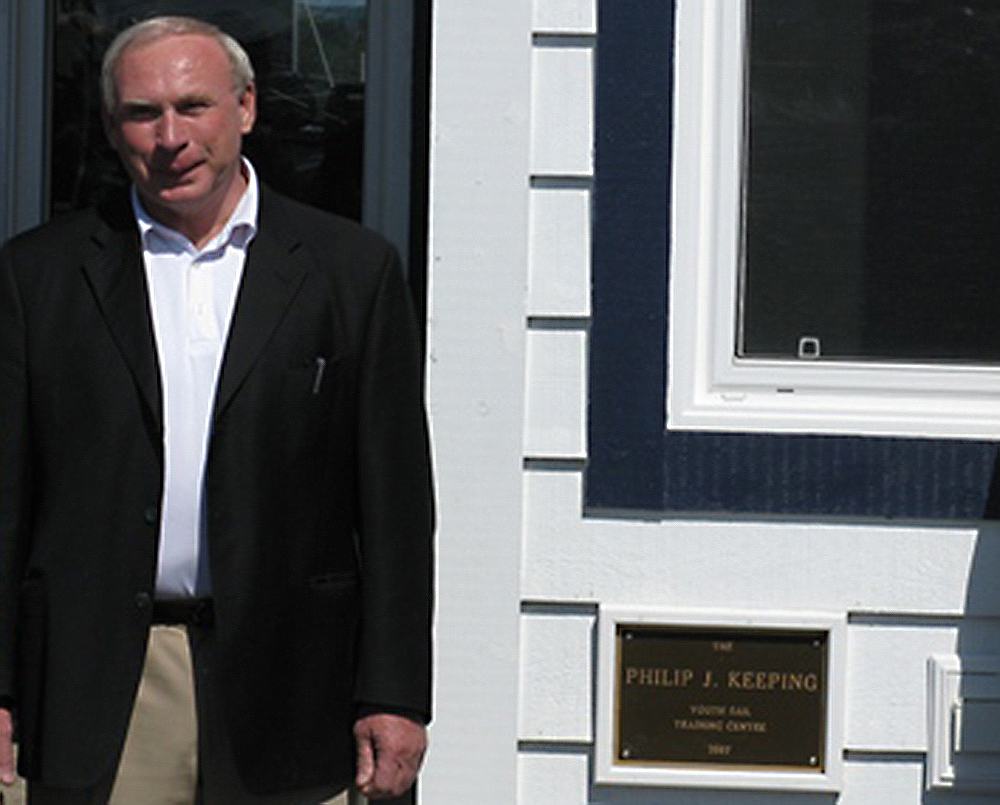
In 2007 the Club did a major fund raising project and began construction of a new Junior Sailing Center. Mr. Phil Keeping was very generous with donations to the RNYC Junior Sailing Program and made his own property available for boat storage and operations. He also constructed a dedicated dock for this purpose. The new Junior Sailing building was named after him and a plaque unveiled in a dedication ceremony in 2009.
 Past Commodore Christopher Pratt made significant contributions with the donation of some of his prints to be used for fund raising for this project as well as other events.
Past Commodore Christopher Pratt made significant contributions with the donation of some of his prints to be used for fund raising for this project as well as other events.
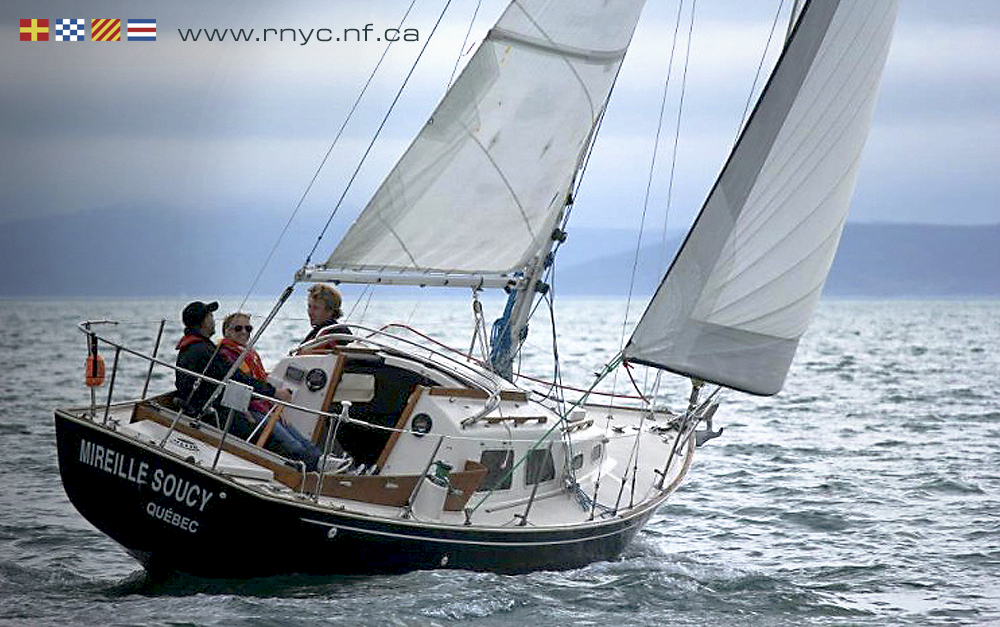
In 2010 a Hinterholler 28 [Mireille Soucy] keelboat was added to the sailing school fleet by its donation from Pierre DeRuelle.
 In 2015 a Grampian 26 [“Go For It”] was also added. These boats are now used for the very successful adult Learn to Sail program.
In 2015 a Grampian 26 [“Go For It”] was also added. These boats are now used for the very successful adult Learn to Sail program.
Livi Allen
 In 2019 16 year old Livi Allen, Instructor in the RNYC Sailing School, participated in five competitive sailing events in Nova Scotia and Ontario. She was the Top Female competitor for 2019 in the Laser 4.7 Class in the prestigious annual Ark Regatta held by the Bedford Basin Yacht Club in Nova Scotia. In August 2019 Livi Allen was the only sailor representing Newfoundland and Labrador at the ILCA Laser 4.7 Youth World Championships in Kingston, Ontario competing against 180 athletes from 35 different countries. [1]
In 2019 16 year old Livi Allen, Instructor in the RNYC Sailing School, participated in five competitive sailing events in Nova Scotia and Ontario. She was the Top Female competitor for 2019 in the Laser 4.7 Class in the prestigious annual Ark Regatta held by the Bedford Basin Yacht Club in Nova Scotia. In August 2019 Livi Allen was the only sailor representing Newfoundland and Labrador at the ILCA Laser 4.7 Youth World Championships in Kingston, Ontario competing against 180 athletes from 35 different countries. [1]
[1] CBC News 08-22-2019 St. John's teen competing in international sailing race.“That's exactly where 16-year-old Livi Allen of St. John's is this week, competing against 180 athletes from 35 different countries. Allen is the only sailor in the competition representing Newfoundland and Labrador.”
Canadian Yachting: 07-25-2017 “Every July dinghy sailors across Canada, the United States and this year as far away as China congregate at the Bedford Basin Yacht Club to showcase their skills which may very well be the beginning of an elite sailing career.”
In the 1990’s and in early 2000’s the club sponsored several rendezvous in Bonavista Bay and one in Trinity. These were wonderful events and gave the power boaters and the sailors a great chance to get together outside the club environment.
This tradition continues with the Trinity Rendezvous, held every two years in Trinity. The RNYC generously donated the trophy for the inaugural Trinity Cup in 2013, which is on display at the Club and is traditionally carried to the event on the previous winners boat and delivered back to the Club via the winning boat.
RNYC hosted the first Easter Seals Regatta in 1990 which began as a national event organized by yacht clubs across the country as a means to raise funds for the Easter Seals program. This event ran until 2014 and raised well over $500,000 in total.
 Another aspect of the club is as a base for the Inshore Rescue Base in Conception Bay for the Canadian Coast Guard. The base was established in 1983 and has been operating from May 24 to Labour Day ever since. The CCG uses the club as a training facility for an annual course for their personnel who crew the RIBs during the summer. The RCMP also uses the club from time to time when there is a fleet of grey RIBs. Over the years the club has hosted workshops like Cold Water Boot Camp from Professor Popsicle and many safety courses under the flag of CYA, now Sail Canada. Through the CYA many members have obtained their power boater operator’s certificate (PCOC).
Another aspect of the club is as a base for the Inshore Rescue Base in Conception Bay for the Canadian Coast Guard. The base was established in 1983 and has been operating from May 24 to Labour Day ever since. The CCG uses the club as a training facility for an annual course for their personnel who crew the RIBs during the summer. The RCMP also uses the club from time to time when there is a fleet of grey RIBs. Over the years the club has hosted workshops like Cold Water Boot Camp from Professor Popsicle and many safety courses under the flag of CYA, now Sail Canada. Through the CYA many members have obtained their power boater operator’s certificate (PCOC).
The club came into the age of the Internet and a domain name was selected and registered and the initial site was constructed and went online in 1999. The site has been modified and updated several times since. A weather station was added in 2004 and soon after was linked to the website. The following year came a webcam and in 2009 Wi-Fi was added with access from the wharves. There was a major facelift of the website in 2014 in association with a local IT company, Triware. The site has since been upgraded to accommodate mobile devices.
There have been several attempts at a newsletter, initially published in 1980 with the next being the Plimsoll which ran from 1984 until 1996 followed by another newsletter in 2000-2001. After a hiatus came Spindrift in 2010 which ran until 2015. All were an important means of communicating and are missed when not continuous.
The club was formally incorporated in 1976 and the first members’ handbook was published. In 1989 a review was made of all the club minutes available and from it came the revised club handbook now in use. Since then there have been periodic updates as required and as such it has become a living document. In 2004 the handbook and constitution were placed on the club website.
Work on the constitution and bylaws was precipitated in 1988 by the introduction of the Companies Act by the Government of Newfoundland. The constitution was rewritten and formed By-Law 1 under the new Companies Act. Part of a major revision to the constitution done in 1993 included the structure of the Flag Officers and Executive.
The original constitution provided for a Fleet Captain, Rear Commodore, Vice Commodore, and Commodore. Each position moved up the ladder to Commodore. This was changed to eliminate the Fleet Captain and allow for 3 Rear Commodores, any one of which could be voted into the position of Vice Commodore, depending on personal circumstances at the time. As membership categories evolve and other fine tuning done on our rules, so does the constitution.
The club got its first female Commodore in 2008 when Janet Organ was elected.
Conclusion
As a club it is important to bring forward the members’ desired visions how the area will be both maintained and evolve to meet the current and future need of the members.
As can be seen, to get the club to the current situation has been a true effort of many hands both seen and unseen. Further efforts with both sail and power vessel training courses, and potentially with other water craft can lead to greater comradery and events for the enjoyment and benefit of all boaters.
The challenge in the future is for all newer members to support the club and help it develop and improve.
Ted Laurentius November, 2016
There have been several attempts at a newsletter, initially published in 1980 with the next being the Plimsoll which ran from 1984 until 1996 followed by another newsletter in 2000-2001. After a hiatus came Spindrift in 2010 which ran until 2015. All were an important means of communicating and are missed when not continuous.
SPINDRIFT ARCHIVE
- Spindrift Oct 2009
- Spindrift May 2010
- Spindrift Aug 2010
- Spindrift Nov 2010
- Spindrift May 2011
- Spindrift Sep 2011
- Spindrift Dec 2011
- Spindrift May 2012
- Spindrift Sep 2012
- Spindrift Dec 2012
- Spindrift May 2013
- Spindrift Sep 2013
- Spindrift Dec 2013
- Spindrift May 2014
- Spindrift Sep 2014
- Spindrift Dec 2014
- Spindrift Nov 2015
Sailing for Everyone!
Register now for the 2021 sailing season.

